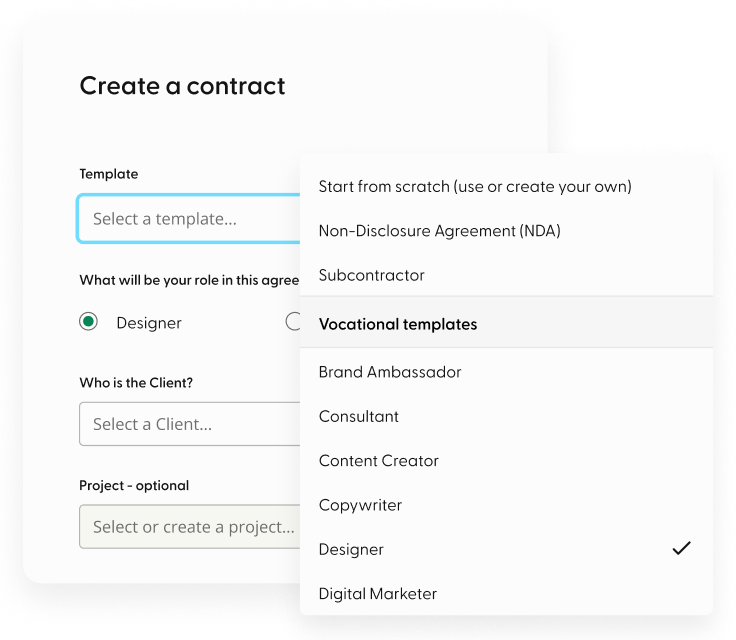Protecting your business and setting expectations for employees is easier with the use of employment contract templates. An employment contract is a legal agreement that sets the working relationship that outlines the terms of employment, including job duties, salary, employment period, vacation time, sick days, paid time, benefits, and more. It also provides legal protection in the event of a dispute between either the employer and the employee or other employees.
These templates offer an easy way to create legally binding contracts quickly and efficiently, saving you time and money. In this article, you will learn about what should be included in an employment contract sample as well as how to create one for your business.
Overview of an Employment Contract Agreement Template
An employment contract template is a pre-designed document that provides a framework for creating an employment agreement between an employer and an employee. This is a document where two parties from the same industry, an employer and an employee, agree on the conditions mentioned.
These templates are widely available and can be used as a starting point to create customized employment contracts.
Here's an overview of employment contracts examples:
Purpose
Employment contracts serve the purpose of establishing a clear and formal agreement between the employer and the employee. They outline the rights, job responsibilities, and obligations of both parties, providing a legal framework for two parties: a job candidate as well as the employer.
Structure and Content
Employment contracts typically include essential sections and provisions that cover various aspects of the employment agreement. These sections may include:
Parties
Identifies the names and addresses of the employer and employee.
Position and Job Description
Clearly defines the employee's job title, job responsibilities, and reporting structure.
Compensation
Outlines the compensation details, including employee's salary, benefits, bonuses, severance pay, and incentives.
Work Schedule
Specifies the normal working hours, days of work, and any other schedule-related details.
Probationary Period
If applicable, defines the duration and conditions of any probationary period.
Termination and Notice Period
Describes the circumstances and procedures for the termination date, including notice period requirements.
Benefits and Perks
Covers employee benefits, such as health insurance, retirement plans, leave policies, and other applicable perks.
Confidentiality and Non-Disclosure
Includes provisions to protect the employer's confidential information and trade secrets.
Intellectual Property
Establishes ownership rights of intellectual property created by the employee during their employment.
Non-Compete and Non-Solicitation
If applicable and enforceable, restricts the employee from competing with the employer or soliciting clients or employees (a non-compete clause).
Dispute Resolution
Specifies the process for resolving disputes, such as arbitration, mediation, or litigation.
Governing Law
Identifies the jurisdiction whose laws govern the interpretation and enforcement of the contract.
Customization
While templates provide a standardized format, they should be customized to reflect the specific needs and requirements of the employer and the employee. Customization may include adjusting compensation details, modifying benefits, and adding or removing provisions based on legal requirements and company policies.
Legal Compliance
Employment contracts are often designed to comply with relevant labor laws and regulations. However, it's important to review and ensure that the template aligns with the specific legal requirements of the jurisdiction in which the employment will take place. Seeking legal advice is advisable to ensure compliance.
Updating and Reviewing
Employment contracts should be periodically reviewed and updated to reflect changes in laws, regulations, or company policies. It's important to keep contracts up to date to ensure compliance and accuracy.
Legal Assistance
While employee contract templates provide a useful starting point, it's advisable to seek legal counsel to review and finalize the contract. A legal professional can ensure that the contract complies with applicable laws and addresses any unique circumstances or specific requirements.
Overall, employment contracts offer a convenient and time-saving solution for creating employment agreements. However, customization, legal review, and ongoing updates are essential to tailor the template to the specific needs of the employer and employee while ensuring compliance with relevant laws and regulations.
Types of Employment Contracts
There are several types of employee contracts that can be used to formalize the employment relationship between an employer and an employee. The specific type of contract used depends on various factors, such as the nature of the work, duration of employment, and the mutual agreement between the parties. Here are some common types of employee contracts:
Permanent Contract
This is the most common type of employment contract, where the employee is hired on a long-term basis without a predetermined end date. It provides ongoing employment, and the relationship continues until either party decides to terminate it, subject to notice periods and legal requirements.
Fixed-Term Contract
This type of contract is used when employment is for a specific period or task. It has a defined start and end date, and the employment relationship automatically terminates at the end of the contract without the need for notice. Fixed-term contracts are often used for project-based work, seasonal employment, or to cover an employee's absence.
Part-Time Contract
Part-time contracts are used when an employee works fewer hours than a full-time employee, typically less than 35-40 hours per week. These contracts specify the number of hours the employee is expected to work and often outline the days and times of work.
Casual/On-Call Contract
Casual contracts are used when the employment relationship is irregular or intermittent. These contracts are typically on an as-needed basis, where the employer calls in the employee when there is work available. Casual employees do not have guaranteed hours and may not receive the same benefits as full-time or part-time employees.
Zero-Hour Contract
This type of contract allows employers to engage employees without guaranteeing any minimum hours of work. The employee is expected to be available for work when needed but does not have a guaranteed number of hours or a fixed schedule. Zero-hour contracts are controversial and subject to varying regulations in different jurisdictions.
Apprenticeship Contract
An apprenticeship contract is a specialized type of contract used for apprenticeship programs. It outlines the terms and conditions of the training and employment arrangement, including the duration of the apprenticeship, the skills to be acquired, and the remuneration.
Probationary Contract
A probationary contract is used to define the terms and conditions for a probationary period during which the employee's performance and suitability for the role are evaluated. It typically specifies the duration of the probationary period and the rights and obligations of both parties during this period.
It's important to note that the availability and legality of these contract types may vary depending on local labor laws and regulations. Employers should consult with legal professionals or labor authorities to ensure compliance with applicable laws and determine the appropriate contract type for their specific circumstances.
Benefits of Using an Employment Agreement Template
Using an employee contract template has numerous benefits for businesses. An employee contract ensures that both the employer and employee are in agreement on the terms of employment, such as:
- Job duties
- Salary
- Working time
- Vacation time
- Sick days
It also provides legal protection in the event of a dispute between employer and employee. Furthermore, having specific agreements such as non-disclosure or confidentiality clauses helps protect confidential information shared between employers and employees while ensuring privacy around sensitive topics discussed within the workplace.
Additionally, employee contracts can be tailored to each individual employment situation which ensures that all parties involved are aware of their rights and obligations before entering into a legally binding agreement.
By using an employee contract template, businesses can save time and money by quickly creating legally binding contracts without having to consult a lawyer. Moreover, these templates provide consistency across all employment agreements so employers can easily manage their workforce with clear expectations set out from the beginning.
How to Create an Effective Employment Contract?
An employment agreement should include various essential elements to clearly define the terms and conditions of the employment relationship. While specific requirements may vary based on local laws and the nature of the job, here are some common elements to include in an employment agreement. The employment contract outlines:
- Parties: Clearly state the names and addresses of both the employer and the employee to establish the parties involved in the agreement.
- Position and Job Description: Clearly define the position/title of the employee and provide a brief description of their duties and responsibilities. This helps avoid confusion about the scope of the role.
- Compensation: Specify the details of the employee's compensation, including their salary or wage, pay frequency, method of payment, and any additional benefits such as bonuses, commissions, or stock options.
- Work Schedule: Outline the normal working hours, days of the week, and any specific provisions regarding shift work, overtime, or on-call duties. If there are any variations or flexibility in the work schedule, it should be clearly stated.
- Probationary Period: If applicable, include the duration and conditions of any probationary period during which the employee's performance will be assessed.
- Termination and Notice Period: Specify the conditions under which the employment can be terminated by either party, including the required notice period. Additionally, outline any circumstances that may warrant an immediate end date for cause (e.g., gross misconduct).
- Benefits and Perks: Detail the employee benefits provided, such as health insurance, retirement plans, vacation and sick leave policies, parental leave, and any other applicable perks or allowances.
- Confidentiality and Non-Disclosure: Include provisions to protect confidential information and trade secrets of the employer, specifying that the employee must maintain confidentiality both during and after their employment.
- Intellectual Property: Clarify the ownership of intellectual property created by the employee during the course of their employment, ensuring that the rights belong to the employer.
- Non-Compete and Non-Solicitation: If applicable and legally enforceable in your competent jurisdiction, include clauses restricting the employee from competing with the employer or soliciting clients or employees for a certain period after their employment ends.
- Dispute Resolution: Outline the process for resolving any disputes or conflicts that may arise during the employment, including whether arbitration or mediation will be used and the applicable jurisdiction for legal proceedings.
- Governing Law: Specify the jurisdiction whose laws will govern the interpretation and enforcement of the employment agreement.
- Entire Agreement: Include a provision stating that the employment agreement represents the entire agreement between the parties and supersedes any prior agreements or understandings unless specifically mentioned in the contract.
It's important to note that employment laws can vary between jurisdictions, so it's advisable to seek legal counsel or consult local employment regulations to ensure compliance with specific requirements in your area.
Creating an effective employee contract template is essential for any business that wants to protect its interests and ensure that all employees are aware of their rights and obligations. However, it’s important to remember there are some common mistakes employers should avoid when creating a new employee contract template.
These include:
- Not including all the necessary elements in the agreement, such as job title, probationary period, job responsibilities, and essential job functions; forgetting to add specific agreements such as non-disclosure or confidentiality clauses;
- omitting additional terms of the agreement so that all parties involved are aware of their rights and obligations before entering into a legally binding agreement;
- failing to check if the contract is legal according to law;
- not clearly defining work hours or pay rate expectations;
- not properly describing benefits offered by the employer;
- or using overly complicated language, which can make it difficult for both parties to understand what is expected from them.
By avoiding these common mistakes, businesses can save time while ensuring consistency across all employment agreements.
4 Tips for Ensuring Compliance with Labor Laws and Regulations
One of the most important aspects of creating an effective employee contract template is ensuring compliance with labor laws and regulations. This includes making sure that any agreements made between employers and employees are fair, just, and in accordance with applicable laws.
Tip #1: Stay up to date
The first step in ensuring compliance is to stay up to date on the latest labor laws and regulations. Each state has its own set of rules and regulations regarding employment contracts, so it's important to research these guidelines before creating a new employee contract template. Additionally, employers should also be mindful of federal laws such as the Fair Labor Standards Act (FLSA) which sets out minimum wage requirements, overtime pay provisions, and other protections for employees.
Tip #2: Tailor your contracts for compliance
Another important factor to consider when creating an employment contract agreement is that labor laws vary depending on the size of a business or organization. For example, small businesses may be subject to different requirements than large corporations in regard to such topics as minimum wage, overtime pay, vacation time, sick days, and termination rights. It's, therefore, important for businesses to understand which laws apply to them in order to ensure compliance with all relevant labor regulations.
Tip #3: Use clear and concise language
In addition to understanding the relevant legal requirements that must be met when creating an employee contract template, businesses should also make sure they are conscientious about their language usage when drafting the agreement. The document should be clear and concise so that both parties understand exactly what is expected from them within the scope of their employment agreement.
Tip #4: Regularly review your contract
Finally, it's important for employers to regularly review their contracts with employees in order to ensure they are still compliant with current legislation and regulations. Regular reviews can help identify areas where a contract may need adjustments or updating in order to remain legally binding and enforceable over time.
By following these tips, businesses can ensure that their employment agreements are always up-to-date and compliant with applicable labor laws and regulations while protecting both employer and employee interests at all times.
Final Thoughts on Using an Employee Contract Template
Using an employee contract template can be a valuable tool for both employers and employees when establishing a clear and formal agreement. Here are some final thoughts on using an employee contract template:
- Legal Compliance: Employment contracts are often designed to comply with relevant labor laws and regulations. By using a template, you can ensure that you include essential legal provisions required by your jurisdiction, such as minimum wage, working hours, leave policies, and non-discrimination clauses. This helps protect the rights of both parties and ensures compliance with applicable laws.
- Time and Efficiency: Templates can save significant time and effort in creating employment contracts from scratch. They provide a framework that covers common provisions, making it easier to fill in specific details and tailor the contract to your specific needs. This can be particularly beneficial for small businesses or startups without dedicated legal departments.
- Customization: While templates provide a solid foundation, it's important to customize the contract to reflect the unique requirements of your organization. Each business has its own policies, practices, and specific job roles. Take the time to review and modify the template to align with your company's needs, ensuring that it accurately reflects the employment terms, compensation structure, benefits, confidentiality agreements, and any other relevant provisions.
- Seek Legal Advice: While templates offer a convenient starting point, it's always wise to consult with a legal professional to ensure that the contract complies with local laws and covers all necessary provisions. Employment laws can vary across jurisdictions, and an attorney can help you navigate any specific legal requirements or address unique circumstances related to your business.
- Regular Updates: Employment contract templates should be periodically reviewed and updated to reflect any changes in legislation or company policies. It's important to keep contracts up to date and ensure they continue to meet legal requirements and align with your organization's practices.
- Communication and Clarity: A well-drafted employment contract is essential for establishing clear expectations and responsibilities between employers and employees. Make sure the contract is written in plain language, avoiding overly complex legal jargon. Clear and concise communication will help both parties understand their rights and obligations, reducing the potential for misunderstandings and disputes.
- Flexibility: While a contract template provides a solid foundation, it's important to remember that each employment relationship is unique. Templates should be seen as a starting point and not as a rigid framework. Flexibility is key, and contracts should allow for necessary modifications to accommodate specific circumstances or negotiations during the hiring process.
How Can Indy Help?
Once you hop on board with Indy's service, you'll have the power to swiftly tweak and personalize those contract templates. In a matter of moments, you can spruce up your project deliverables, employment period deadlines, payment terms, intellectual property rights, and termination clauses to fit your needs.
But here's the real kicker with Indy's contracts - they seamlessly connect to all their other nifty tools. Picture this: you can effortlessly link your independent contractor agreement (own contract when you are a self-employed person) to specific client contact info, project deets, proposals, invoices, and even time tracking for those hourly gigs. It's like having a one-stop shop to tackle all your work-related stuff. How cool is that?
Summary
In conclusion, using an employee contract template can be a valuable resource for employers and employees. It helps ensure legal compliance, saves time and effort, provides a starting point for customization, and promotes clear communication.
However, it's important to seek legal advice, customize the template to fit your organization's needs, and keep contracts updated to remain legally compliant and reflect any changes in circumstances.




